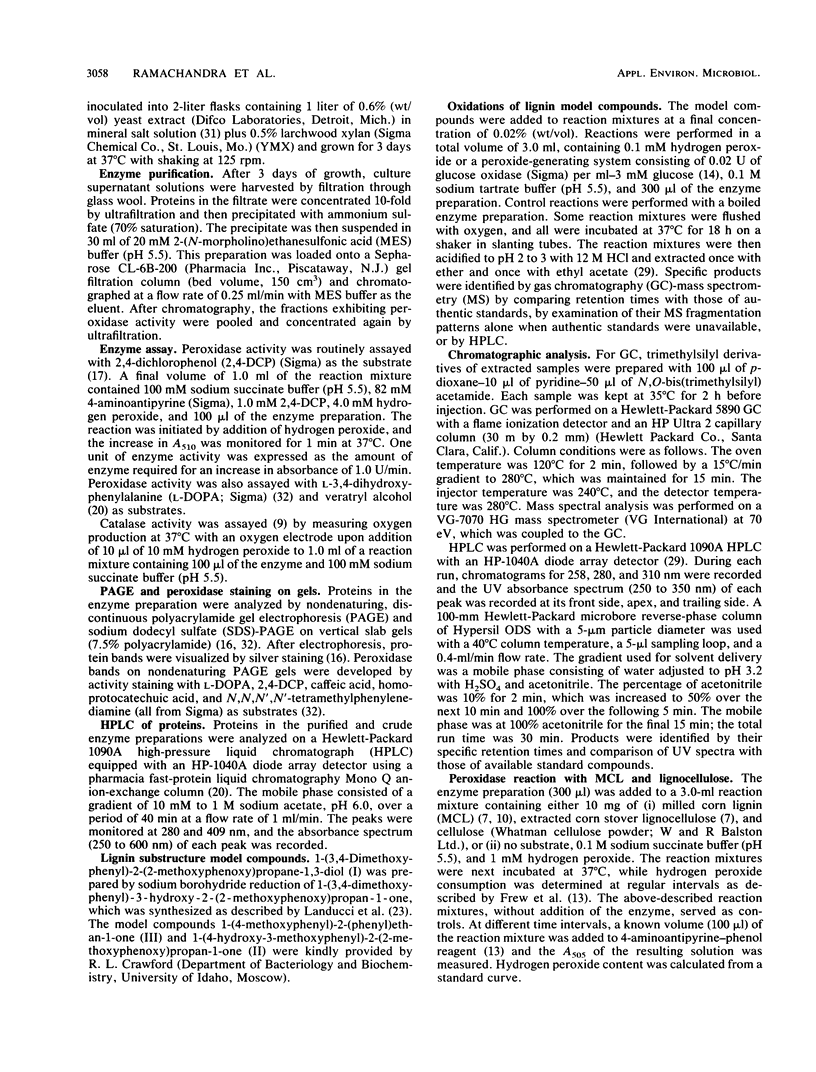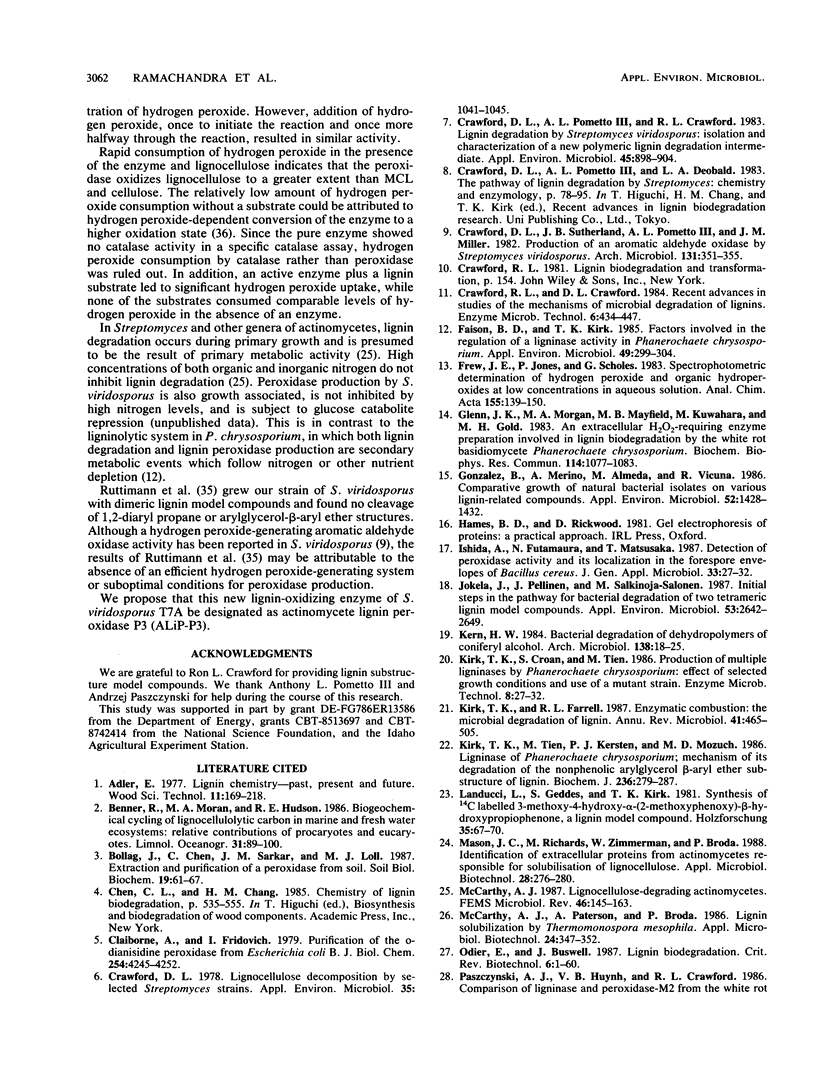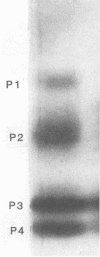Abstract
Previously we reported production of an extracellular lignin-inducible peroxidase by Streptomyces viridosporus (M. Ramachandra, D.L. Crawford, and A.L. Pometto III, Appl. Environ. Microbiol. 53:2754-2760, 1987). This peroxidase was shown to oxidize 3,4-dihydroxyphenylalanine, 2,4-dichlorophenol, homoprotocatechuic acid, caffeic acid, and N,N,N',N'-tetramethylphenylenediamine and was found in higher than normal levels in strains enhanced for lignocellulose degradation. In the present study, we used a pure extracellular enzyme preparation with high peroxidase isoform P3 activity to oxidize lignin substructure model compounds of both the 1,2-diaryl propane and arylglycerol-beta-aryl ether types and containing C alpha-carbonyl and C alpha-hydroxyl groups. The reactions were monitored by gas chromatography-mass spectrometry and high-pressure liquid chromatography techniques. In the presence, but not the absence, of hydrogen peroxide, the enzyme preparation catalyzed C alpha-C beta bond cleavage in the side chains of the diaryl ethers 1-(3,4-dimethoxyphenyl)-2-(2-methoxyphenoxy)propane-1,3-diol (I) and 1-(4-hydroxy-3-methoxyphenyl)-2-(2-methoxyphenoxy)propan-1-one (II) and the diaryl ethane 1-(4-methoxyphenyl)-2-(phenyl)ethan-1-one (III). Rapid hydrogen peroxide consumption was observed when the enzyme preparation was added to either milled corn lignin or lignocellulose. Additional characterizations showed that this enzyme is a heme protein (Soret band, 408 nm) and a major component of the ligninolytic system of S. viridosporus T7A. This is the first report of a lignin peroxidase in a bacterium. We have designated this new lignin peroxidase as ALiP-P3.
Full text
PDF






Images in this article
Selected References
These references are in PubMed. This may not be the complete list of references from this article.
- Claiborne A., Fridovich I. Purification of the o-dianisidine peroxidase from Escherichia coli B. Physicochemical characterization and analysis of its dual catalatic and peroxidatic activities. J Biol Chem. 1979 May 25;254(10):4245–4252. [PubMed] [Google Scholar]
- Crawford D. L. Lignocellulose decomposition by selected streptomyces strains. Appl Environ Microbiol. 1978 Jun;35(6):1041–1045. doi: 10.1128/aem.35.6.1041-1045.1978. [DOI] [PMC free article] [PubMed] [Google Scholar]
- Crawford D. L., Pometto A. L., Crawford R. L. Lignin Degradation by Streptomyces viridosporus: Isolation and Characterization of a New Polymeric Lignin Degradation Intermediate. Appl Environ Microbiol. 1983 Mar;45(3):898–904. doi: 10.1128/aem.45.3.898-904.1983. [DOI] [PMC free article] [PubMed] [Google Scholar]
- Faison B. D., Kirk T. K. Factors Involved in the Regulation of a Ligninase Activity in Phanerochaete chrysosporium. Appl Environ Microbiol. 1985 Feb;49(2):299–304. doi: 10.1128/aem.49.2.299-304.1985. [DOI] [PMC free article] [PubMed] [Google Scholar]
- Glenn J. K., Morgan M. A., Mayfield M. B., Kuwahara M., Gold M. H. An extracellular H2O2-requiring enzyme preparation involved in lignin biodegradation by the white rot basidiomycete Phanerochaete chrysosporium. Biochem Biophys Res Commun. 1983 Aug 12;114(3):1077–1083. doi: 10.1016/0006-291x(83)90672-1. [DOI] [PubMed] [Google Scholar]
- Gonzalez B., Merino A., Almeida M., Vicña R. Comparative growth of natural bacterial isolates on various lignin-related compounds. Appl Environ Microbiol. 1986 Dec;52(6):1428–1432. doi: 10.1128/aem.52.6.1428-1432.1986. [DOI] [PMC free article] [PubMed] [Google Scholar]
- Jokela J., Pellinen J., Salkinoja-Salonen M. Initial steps in the pathway for bacterial degradation of two tetrameric lignin model compounds. Appl Environ Microbiol. 1987 Nov;53(11):2642–2649. doi: 10.1128/aem.53.11.2642-2649.1987. [DOI] [PMC free article] [PubMed] [Google Scholar]
- Kern H. W. Bacterial degradation of dehydropolymers of coniferyl alcohol. Arch Microbiol. 1984 May;138(1):18–25. doi: 10.1007/BF00425401. [DOI] [PubMed] [Google Scholar]
- Kirk T. K., Farrell R. L. Enzymatic "combustion": the microbial degradation of lignin. Annu Rev Microbiol. 1987;41:465–505. doi: 10.1146/annurev.mi.41.100187.002341. [DOI] [PubMed] [Google Scholar]
- Kirk T. K., Tien M., Kersten P. J., Mozuch M. D., Kalyanaraman B. Ligninase of Phanerochaete chrysosporium. Mechanism of its degradation of the non-phenolic arylglycerol beta-aryl ether substructure of lignin. Biochem J. 1986 May 15;236(1):279–287. doi: 10.1042/bj2360279. [DOI] [PMC free article] [PubMed] [Google Scholar]
- Paszczyński A., Huynh V. B., Crawford R. Comparison of ligninase-I and peroxidase-M2 from the white-rot fungus Phanerochaete chrysosporium. Arch Biochem Biophys. 1986 Feb 1;244(2):750–765. doi: 10.1016/0003-9861(86)90644-2. [DOI] [PubMed] [Google Scholar]
- Pometto A. L., Crawford D. L. Catabolic Fate of Streptomyces viridosporus T7A-Produced, Acid-Precipitable Polymeric Lignin upon Incubation with Ligninolytic Streptomyces Species and Phanerochaete chrysosporium. Appl Environ Microbiol. 1986 Jan;51(1):171–179. doi: 10.1128/aem.51.1.171-179.1986. [DOI] [PMC free article] [PubMed] [Google Scholar]
- Pometto A. L., Crawford D. L. Effects of pH on Lignin and Cellulose Degradation by Streptomyces viridosporus. Appl Environ Microbiol. 1986 Aug;52(2):246–250. doi: 10.1128/aem.52.2.246-250.1986. [DOI] [PMC free article] [PubMed] [Google Scholar]
- Pridham T. G., Gottlieb D. The Utilization of Carbon Compounds by Some Actinomycetales as an Aid for Species Determination. J Bacteriol. 1948 Jul;56(1):107–114. doi: 10.1128/jb.56.1.107-114.1948. [DOI] [PMC free article] [PubMed] [Google Scholar]
- Ramachandra M., Crawford D. L., Pometto A. L. Extracellular Enzyme Activities during Lignocellulose Degradation by Streptomyces spp.: A Comparative Study of Wild-Type and Genetically Manipulated Strains. Appl Environ Microbiol. 1987 Dec;53(12):2754–2760. doi: 10.1128/aem.53.12.2754-2760.1987. [DOI] [PMC free article] [PubMed] [Google Scholar]
- Renganathan V., Miki K., Gold M. H. Multiple molecular forms of diarylpropane oxygenase, an H2O2-requiring, lignin-degrading enzyme from Phanerochaete chrysosporium. Arch Biochem Biophys. 1985 Aug 15;241(1):304–314. doi: 10.1016/0003-9861(85)90387-x. [DOI] [PubMed] [Google Scholar]
- Renganathan V., Miki K., Gold M. H. Role of molecular oxygen in lignin peroxidase reactions. Arch Biochem Biophys. 1986 Apr;246(1):155–161. doi: 10.1016/0003-9861(86)90459-5. [DOI] [PubMed] [Google Scholar]
- Tien M., Kirk T. K. Lignin-Degrading Enzyme from the Hymenomycete Phanerochaete chrysosporium Burds. Science. 1983 Aug 12;221(4611):661–663. doi: 10.1126/science.221.4611.661. [DOI] [PubMed] [Google Scholar]
- Tien M., Kirk T. K. Lignin-degrading enzyme from Phanerochaete chrysosporium: Purification, characterization, and catalytic properties of a unique H(2)O(2)-requiring oxygenase. Proc Natl Acad Sci U S A. 1984 Apr;81(8):2280–2284. doi: 10.1073/pnas.81.8.2280. [DOI] [PMC free article] [PubMed] [Google Scholar]
- Tien M. Properties of ligninase from Phanerochaete chrysosporium and their possible applications. Crit Rev Microbiol. 1987;15(2):141–168. doi: 10.3109/10408418709104456. [DOI] [PubMed] [Google Scholar]




